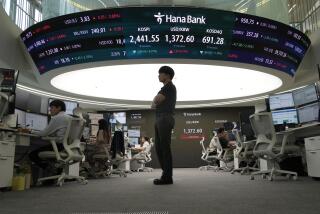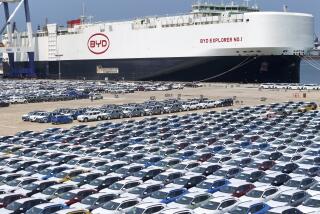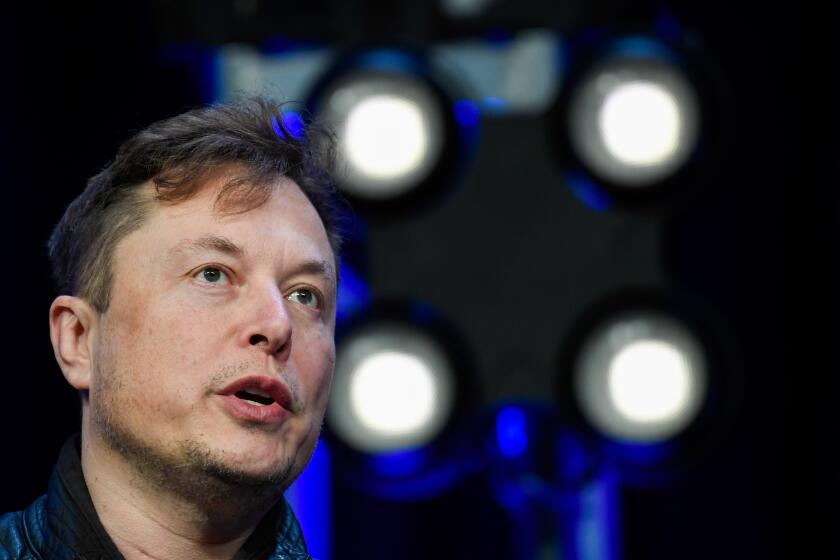PACIFIC REPORT : A Bumpier Road Ahead : Cars: A reputation for poor quality, shrinking markets and much higher wages are slowing the growth of South Korea’s auto industry.
SEOUL — While auto makers around the world are tightening their belts to adjust to shrinking markets and an overabundance of cars, South Korea’s fledgling industry continues to build new factories. There’s just one problem: They aren’t selling enough cars.
By year-end, Korean auto makers will have the capacity to build 2.2 million cars, up 17% from 1989. But the five auto makers will probably sell about 1.4 million cars, only slightly more than last year, analysts predict. Sales in key markets continue to shrink, with exports to the United States in January down 35% from the year-earlier month.
A lingering reputation for poor quality, combined with stagnating international markets and skyrocketing wages in Korea, is stalling the growth of an industry that the nation once looked to as the engine of the Korean miracle.
“Our labor costs have gone up dramatically, and they haven’t been offset by increases in productivity,” said Robert Stramy, executive vice president at Daewoo Motors Co., a joint venture between General Motors and Daewoo Heavy Industries.
Japan’s reputation for quality has also eclipsed Korea’s effort to try to sell more upscale cars. “When things get tight and prices are about equal, people tend to move toward Japanese products,” Stramy said.
A dramatic 29% increase in Korean domestic sales last year helped avert disaster. But Korea’s auto industry can no longer depend on a large, protected domestic market to provide a steady flow of fat profits to finance its exports.
With Seoul’s streets near gridlock after a huge increase in automobile ownership, the government is putting the brakes on auto use. It is considering increased taxes on cars and higher gasoline prices and has cracked down on traffic violations. Car owners are also barred from driving on certain days of the month, depending on their license numbers. These measures make auto ownership less attractive.
There are also more companies scrambling for a share of that lucrative domestic market. Since 1988, when the Korean government removed regulations barring new entrants in the industry, a host of new Korean firms have entered the fray--boosting competition and shrinking margins.
Kia Corp., best known for making commercial vehicles such as trucks and vans, entered the passenger market in 1987. Last year it produced 150,000 autos, and it plans to raise production to 950,000 by 1995. Ssangyong, which dominates the Jeep-style market, will soon begin selling sports cars. The company also announced last month a 10-year agreement with Mercedes-Benz to produce minibuses, vans and trucks.
“We weren’t sure if intervention (in the private sector) was good or not,” says Kwon Moon Yong, director general of industrial policy coordination at Korea’s powerful Economic Planning Board, referring to the ongoing debate about whether to control entrance into the auto industry.
The development of a domestic auto industry was considered strategic to Korea’s economy because it was expected to help develop a broad-based industry in machine tools, tires and automobile components. The industry would also be a large consumer of products from Korea’s giant steel industry.
With a relatively small domestic market, however, the industry has been forced to compete in the export market against the world’s best producers and marketers. With Japan making rapid technological progress on all fronts, Korea has been slow to develop the machinery and parts infrastructure it needs to be competitive.
Forced to raise prices and slow to come out with new models, Korean auto makers’ popularity has fallen after explosive growth in the early 1980s. Exports last year totaled about 370,000 units, down 40% from the high in 1988.
Hyundai Motor Co., which launched Korea’s industry in 1985 with the export of its Excel to the American market, is trying to reduce its heavy dependence on the U.S. market by selling aggressively in such newly opened markets as Eastern Europe and the Soviet Union. Those markets, however, constitute a small part of total world demand.
The key source of Korea’s problems is labor costs that have nearly doubled in the past three years. With the average Korean auto worker producing just 19.3 cars a year, about one-third the Japanese rate, Korea lost its only advantage--price.
Korean auto makers are trying to automate in an effort to boost productivity and cut costs, but the going is slow.
“Our manufacturing was based on craftsmanship,” said C. W. Bahk, director of the industrial automation service of the Korea Productivity Center, a government group established to help manufacturers automate. “All the managers needed was a disciplined work force, so they implemented a military-style organization.”
Now, as companies seek to automate and boost quality, they must develop the participatory organization Japan has developed.
“Automating means taking a completely new approach in plant management and engineering. We must start from the beginning,” Bahk said.
Korean companies have traditionally targeted the low-end market. Recently, however, they have been knuckled between higher prices for parts they need from Japan and a competitive U.S. market that has prevented them from raising prices. Korean makers accuse Japanese companies of dropping prices on their low-end models to undercut Korean companies.
“It is a rough market segment at the entry level,” said Stramy, who was sent to Daewoo from General Motors. Daewoo supplies GM its Pontiac Le Mans model.
Hyundai and Daewoo are coming out with larger models in hopes of expanding beyond the subcompact market and into the more profitable market for compact cars. But competition there depends on quality and response to consumer requirements, areas that haven’t been Korean strengths.
Hyundai has been plagued by poor ratings on frequency-of-repair ratios, and the resale values of Korean cars have been far lower than that of Japanese models.
“American consumers’ expectations for Korean cars were too high,” a Kia Economic Research Institute analyst said. “They thought Korean cars would be better.”
“Unless they develop a very high-quality car, they aren’t going to sell very many,” said Hitoshi Nishiyama, analyst at Nomura Research Institute in Japan. “It’s a zero-sum game; they are competing in mature markets with entrenched companies.”
Korean companies have also suffered from trade frictions with the United States. Ford Motor cut purchases of its Festiva models from Kia Corp. last year after reports that Korean government officials were harassing buyers of Ford automobiles as part of a campaign that in effect discouraged purchases of foreign products.
One thing the Korean companies have going for them are the fruits of an aggressive program to localize production of auto components in an effort to reduce dependence on Japanese parts. Hyundai, for example, has managed to reduce its royalty costs to 0.7% of its $6.6 billion in sales last year, compared to 0.8% the year before.
Royalty payments and parts imports should shrink further as Hyundai begins production of a new engine developed by its own engineers at a cost of $140 million. Most of its current cars use engines made with technology licensed from Mitsubishi Motors.
Daewoo also announced last month that it had developed its own engine. And the company said it is trying to respond more effectively to the market, softening the feel of manual gear shifts and offering a smoother ride in response to consumer comments.
KOREA’S SLUMPING AUTO INDUSTRY
Capacity has grown sharply as Korean auto makers expand plants, but sales have failed to keep pace and exports are actually declining.
Exports:
1985: 123,110
1986: 306,369
1987: 546,310
1988: 576,144
1989: 356,040
1990: 374,000
1991*: 320,000
* estimate
Figures represent number of units
Capacity:
1985: 644,000
1986: 1,855,000
1987: 1,469,000
1988: 1,736,000
1989: 1,872,000
1990: 2,000,000
1991*: 2,200,000
* estimate
Figures represent number of units
Total Sales:
1985: 318,162
1986: 601,546
1987: 979,379
1988: 1,083,655
1989: 1,129,470
1990: 1,330,000
1991*: 1,400,000
* estimate
Figures represent number of units






